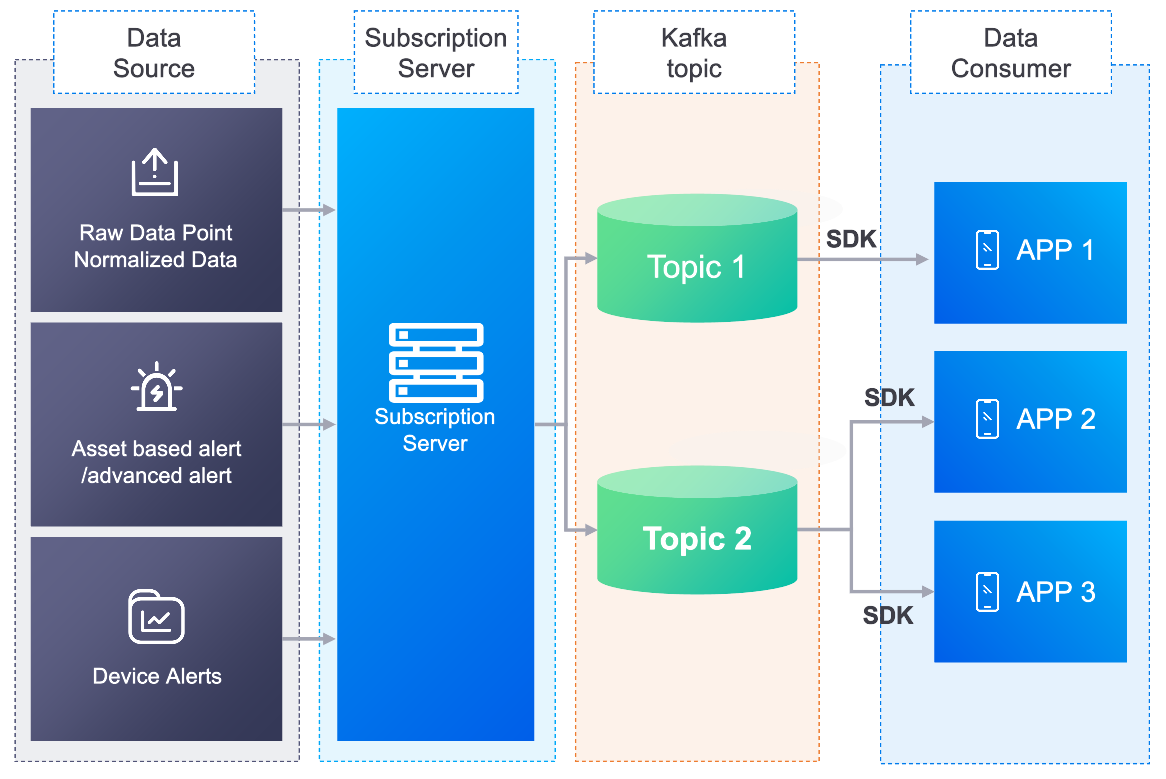EnOS Data Subscription Service Overview¶
The EnOS Data Subscription service improves the performance of API calls with active data push. It supports multi-data source subscription, subscription task management, and calling the Data Subscription SDK. With this data subscription service, applications do not need to call APIs repeatedly and frequently to get asset data. greatly improving API performance and reducing costs. The push content includes:
Asset time-series data
Alert engine data
Asset event data
Return result data
The major components and architecture of the Data Subscription service are as follows.

Raw data flows into the data subscription service. Users can configure data subscription parameters according to their own business needs. The subscribed data is actively pushed into Kafka Topics. Downstream clients can consume the data in applications by the official SDKs, achieving decoupling of data production and data consumption.
Applicable Scenarios¶
IT/OT application developers can subscribe to real time and offline asset data. as well as alarm data.
Product Advantages¶
Data Production and Data Consumption Decoupling: Supporting multiple data filtering conditions to subscribe the measurement point data, alert data, and event data of specific organizations and assets. Subscribed data will be stored in Kafka Topics. The stored data will be consumed only when the data consumption clients are started.
Data Flow Control: Applications will actively pull the subscribed data from Kafka Topics, achieving client-side data flow control.
Cross-organization Data Subscription: Leveraging Kafka’s at-least-once message delivery semantics to ensure that subscribed data is consumed at least once, thus avoiding data loss. Supporting cross-organization data subscription through purchasing applications of other organizations.
Data Consumption Groups: Supporting consumer groups. A topic can be consumed by multiple consumers (2 consumers are supported currently) in a same group at the same time, improving data consumption efficiency in case of huge data volume. A topic can also be consumed by multiple consumer groups.
Data Consumption at Breakpoints: Supporting the resuming of data consumption at breakpoint. Within 24 hours after the consumer client stops consuming data, the same consumer group can be used to continue consuming subscribed data from the breakpoint.
Running Status Monitoring: Monitoring the running statistics of data subscription jobs (producer rates, consumer rates, offset, and lag) to ensure that subscribed data is consumed in time without delay.
Main Functions¶
Multiple data source subscription¶
EnOS Cloud offers multi-source data subscription services, enabling multiple customers to utilize dedicated subscription channels for the following data types:
Time series data subscription
Alert data subscription
Device management event subscription
Device event report subscription
For more information, see Developing Data Subscription Jobs
Visualized configuration¶
A GUI is available for you to customize the data subscription configuration, such as creating, configuring, starting, stopping, or deleting subscription jobs.
EnOS Cloud supports viewing the running statistics, see Monitoring the Running Statistics of Data Subscription Jobs. For detailed information about creating data subscription jobs, see Developing Data Subscription Jobs.
Data subscription SDK¶
Developers can leverage the dedicated Data Subscription SDK to quickly build applications for consuming subscribed data. EnOS Cloud currently supports the Java SDK. For steps on consuming subscribed data, refer to Consuming Subscribed Data.
Usage Limitation¶
When using Data Subscription, note the following usage limitation:
Up to 100 subscription jobs are supported in an OU.
Up to 100000 model points are supported for one subscription job in an OU.
Note
The limitation values below are the default values. To change the default values, contact the system administrator.